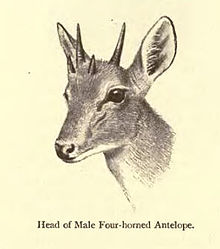Boselaphini
| Boselaphini | |
|---|---|

| |
| Nilgai | |

| |
| Four-horned antelope | |
| Scientific classification | |
| Domain: | Eukaryota |
| Kingdom: | Animalia |
| Phylum: | Chordata |
| Class: | Mammalia |
| Order: | Artiodactyla |
| Family: | Bovidae |
| Subfamily: | Bovinae |
| Tribe: | Boselaphini Knottnerus-Meyer,1907 |
| Genera | |
|
and seetext. | |
Boselaphiniis atribeofbovines.It contains only twoextantgenera,each with a single extantspecies.
Description[edit]
The Boselaphini or four-hornedantelopetribe are the last survivors of a form very similar to that of the ancestors of the broader subfamily. The oldest fossil members of the tribe, such asEotragus,date to theMioceneabout 18 to 20 million years ago. Such fossils possessed horns very similar to those of males belonging to the two living species, although in some cases, they were also present in females.[1]
Both extant species have relatively primitive anatomical and behavioural characteristics and the females have no horns. They are native to the rapidly diminishing forests ofIndia,and tend to avoid open plains. Thenilgaihas been introduced into southernTexaswhere a population of a little under 15,000 animals provides some long-term insurance for its survival.[citation needed]
Genera[edit]
Extant species[edit]
| Image | Genus | Species |
|---|---|---|
 |
BoselaphusBlainville, 1816 |
|
 |
TetracerusLeach, 1825 |
|
Phylogeny[edit]
The following are the genera classified under the tribe. Genera marked with † are extinct.[2]
Tribe Boselaphini
- Boselaphus
- Boselaphus tragocamelus-Nilgaior blue bull (not to be confused with the extinctbluebuckHippotragus leucophaeus)
- †Elachistoceras
- †Duboisia
- †Dystychoceras
- †Eotragus
- †Kipsigicerus
- †Mesembriportax
- †?Miotragocerus
- †Pachyportax
- †Perimia
- †Phronetragus
- †Pliodorcas
- †Plioportax
- †Proboselaphus
- †Protragocerus
- †Ruticeros
- †Samokeros
- †Selenoportax
- †Sivaportax
- †Sivoreas
- †Strogulognathus
- Tetracerus
- †?Tragoportax
- †Tragoreas
References[edit]
- ^Kostopoulos, D.S. (2005)."The Bovidae (Mammalia, Artiodactyla) from the late Miocene of Akkaşdaği, Turkey"(PDF).Geodiversitas.27(4): 747–791. Archived fromthe original(PDF)on 2006-12-02.
- ^Haaramo, M."Mikko's Phylogency Archive (Boselaphini)".Retrieved25 March2011.
- ^Leslie, D.M. & Sharma K. (2009)."Tetracerus quadricornis(Artiodactyla: Bovidae) ".Mammalian Species(843): 1–11.doi:10.1644/843.1.
